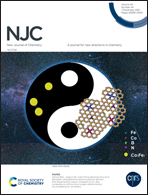A Pt3 cluster anchored on a C2N monolayer as an efficient catalyst for electrochemical reduction of nitrobenzene to aniline: a computational study†
Abstract
The electrochemical reduction of nitrobenzene to aniline (NBER) under ambient conditions is of great significance for sustainable industry and life. In this work, by means of density functional theory (DFT) computations, we have systematically investigated the potential of several (Ptn, n = 1–6 and 13) nanoclusters anchored on a holey C2N monolayer (Ptn/C2N) as NBER electrocatalysts. Our results revealed that Ptn/C2N materials exhibit high stability due to the strong interaction between the Pt-5d orbital and the N-2p orbital in C2N. Interestingly, among these Ptn/C2N catalysts, Pt3/C2N is the most active catalyst for NBER because of its rather small limiting potential (−0.19 V), in which the hydrogenation of Ph–NO2* to Ph–NOOH* is identified as the potential-determining step. Compared with other catalysts, the strongest binding strength of Ph–NOOH* on Pt3/C2N is responsible for its superior catalytic activity towards NBER. Our results provide a promising Pt cluster-based catalyst with high efficiency for NBER, which could open a new door for sustainable aniline production.



 Please wait while we load your content...
Please wait while we load your content...